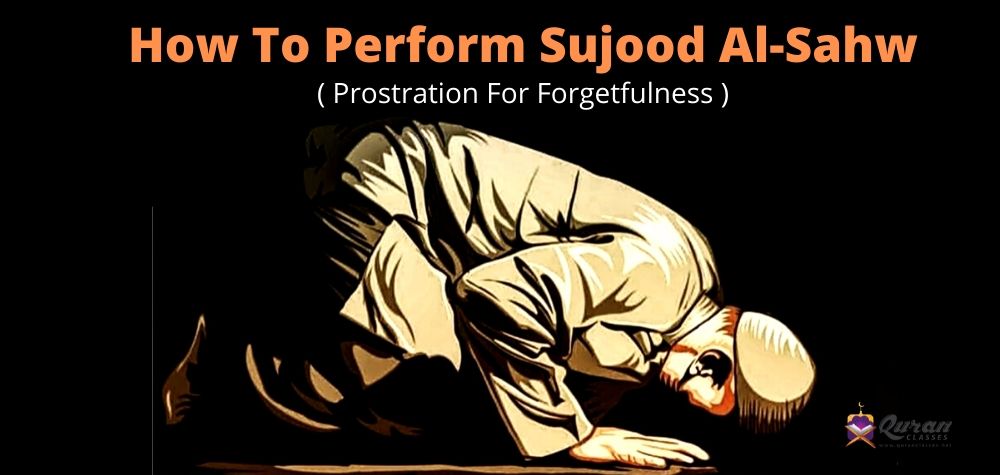Sunnah When Night Falls
December 27, 2019How To Pray Tahajjud
December 30, 2019
How to Perform Sujood As-Sahw:
Sujood As-Sahw is the prostration for forgetfulness. Many people are unfortunately ignorant about the rulings of Sujood As-Sahw and may perform it for the wrong reasons, or neglect it all together. Sometimes it may happen that we forget something in our prayers, make a mistake or have doubt whether we have completed an certain action or not. So to compensate for this forgetfulness, one is to perform two prostrations at the end of the prayer which should be performed like any regular prostration during our daily prayers. There is no special Dhikr to be recited, rather, as usually done in the prostrations, we ecite [(Subhana Rabbiyal-A’la (Glory be to my Lord, The Most High)] three times and say between the two prostrations (during sitting) Rabb ighfir li, Rabb ighfir li (Lord forgive me, Lord forgive me).
Sujood As-Sahw should be performed for three reasons:
1. Having added an extra action in the prayer (Az-Ziyaadah)
2. Having omitted an action in the prayer (An Naqs)
3. Being uncertain and in a state of doubt of a particular action (Ash-Shak)
Before we begin, it’s also important to keep in mind that the prayer is divided into three categories of action:
1. Actions that are essential/pillars of the prayer (Fard)
2. Actions that are obligatory (Wajib)
3. Actions that are Sunnah.
*An Addition in the Prayer*
If someone deliberately adds an extra ruko, sujood, rakah…etc. to the prayer, then his prayer will be nullified, but if he does it out of forgetfulness, then he must perform Sujood as-Sahw at the end of the prayer. In the case in which one added (an essential or obligatory action) to the prayer forgetfully, for example, made an extra ruk’oo, sajdah, rak’ah, …etc. and he remembers it after he completed the action or after he finished the prayer, then according to the majority of scholars, one should perform sujood al sahw AFTER the tasleem. He/she is to make the tasleem, then perform the two prostrations of forgetfulness, get back up and make another tasleem.
The evidence regarding this is related to a hadith of ‘Abdullah (b. Mas’ud) who reported: The Messenger of Allah (ﷺ) led us five (rak’ahs in prayer). We said: Messenger of Allah, has the prayer been extended? He said: What is the matter? They said: You have said five (rak’ahs). He (the Prophet) said: Verily I am a human being like you. I remember as you remember and I forget just as you forget. He then performed two prostrations as (compensation of) forgetfulness. [Muslim 572 k]
– Giving Salutations (salam) before completion of the Prayer (Cutting the prayer short)
In the case where someone cuts their prayers short out of forgetfulness and only remembered after they had finished the prayer, they must return, complete the prayer and offer sujood as sahw. Due to performing the extra unnecessary tasleem (when the prayer was cut short) the prostration for forgetfulness should be done after the tasleem.
Abu Hurairah who narrated: The Messenger of Allah (ﷺ) led us in praying ‘Asr, and he said the salam after two rak’ahs. Dhul-Yadain stood up and said: ‘Has the prayer been shortened, O Messenger of Allah (ﷺ) or did you forget?’ The Messenger of Allah (ﷺ) said: ‘Neither.’ He said: ‘One of them happened, O Messenger of Allah (ﷺ).’ The Messenger of Allah (ﷺ) turned to the people and said: ‘Is Dhul-Yadain speaking the truth?’ They said: ‘Yes.’ So the Messenger of Allah (ﷺ) completed what was left of the prayer, then he prostrated twice when he was sitting after the taslim.” [An-Nasa’i 1226]
However, if one was to remember while they are performing the addition, then he must leave the addition, continue the prayer, and perform sujood as-sahw at the end of the prayer. For example, if one is in the 5th rakah, then remembers, he must immediately go down for tashahhud, complete it, say the tasleem and offer sujood as-sahw and offer another tasleem. If he was to remember during the tashahhud for example, or after the prayer, then he should perform sujood as sahw after the tasleem and then perform another tasleem.
*An Omission in the Prayer*
Forgetfully omitting an action in the prayer depends on whether the action omitted was
1. a Sunnah
2. Obligatory or
3. A pillar of the prayer
– If one was to omit a Sunnah of the prayer, such as recitation of a second Surah (after Al-Fatiha) or raising the hands…etc. Then a prostration of forgetfulness is not required and the prayer will be valid. Accordingly to Shaykh ‘Abd al-‘Azeez ibn Baaz, perfoming the prostration of forgetfulness for omitting a Sunnah is permissible, but it is not obligatory.
– If one was to omit an obligatory act of prayer (wajib), such as the middle tashhahud or saying Subhana Rab al A’la in the sujood, and moves on to the next part of the prayer, then all he/she is only required to do is perform the sujood as-sahw at the end of the prayer, before making the tasleem.
The Messenger of Allah (ﷺ) led us two rak’ahs of prayer in one of the (obligatory) prayers and then got up and did not sit (for the middle tashhahud), and the people stood up along with him. When he finished the prayer and we expected him to pronounce salutation (make the tasleem), he said:” Allah is Most Great” while sitting and made two prostrations before tasleem and then pronounced (the, final) tasleem. [Muslim 570 a]
If one, for example, was determined to get up from the second rakah (without performing the tashahhud) but did not, then he should continue his prayer normally and nothing is due upon him. However, if he got up after the second rakah, forgetting the tashahhud, but has not fully stood up for the third rak’ah, he/she may sit down, perform the tashahood and make sujood as sahw at the end of the prayer after the tasleem. If one fully stands up, then he should continue on with the prayer and perform sujood as sahw at the end of the prayer, before the tasleem.
The Prophet (ﷺ) said: When an imam stands up at the end of two rak’ahs , if he remembers before standing straight up, he should sit down, but if he stands straight up, he must not sit down, but perform the two prostrations of forgetfulness. [Abi Dawud 1036]
– If one is to omit the initial Takbeer (Takbeeratul-Ihram), then whether it was deliberate or forgetfully, the prayer is invalid. If it is something (wajib or fard) other than the initial Takbeer, then if it is left deliberately, his prayer is nullified. If one was to omit an essential part of the prayer (a fard) forgetfully like a rukoo, sujood, reciting fatiha…etc., the rak’ah in which these actions were omitted becomes invalid, so performing only the sujood as-sahw will not be sufficient, but rather he/she must make up the entire rakah. One of three scenarios must apply regarding omitting a pillar (a fard) of the prayer:
1. Either, the omitted action is remembered before reaching the same point in the next rak’ah, so he should go back and perform the essential part in which he missed and then continue normally with whatever comes after it
2. Or, if the omitted action is not remembered until he reached the same point in the next rak’ah, then this rak’ah becomes invalid, so he should continue on to the next rak’ah, which now replaces the rak’ah that was invalid.
3. Or, if the omitted action was not remembered until at the completion of the prayer, he should go back, perform the missed ra’kah and perform the prostration of forgetfulness.
*In either case, the prostration of forgetfulness must be made at the end of the prayer after the tasleem.
So for example, if one made only one sajdah in the first rak’ah and stood right up without sitting or performing the second prostration, then he/she starts reciting Quran and remembers that he did not sit between the two prostrations or perform the second sajdah, in this case, he should go back in the sitting position (as between the two prostrations) then prostrate and then stand up and continue the prayer and perform the prostration of forgetfulness at the end of the prayer after the tasleem.
For the one who remembered after he reached the same point in the next ra’kah, for example, one had missed a ruk’u in the first rak’ah but only remembered during his sujood (passing the point of ru’ku) of the second rak’ah, therefore the first rak’ah becomes invalid, and therefore the second rak’ah becomes his first rak’ah and he should now add another rak’ah to his prayer and perform the sujood as sahw after the tasleem.
And for the one who completely missed a rak’ah, or an essential part of the prayer and only remembered after made the tasleem, he should get up and perform the rak’ah and then perform the prostration of forgetfulness after the tasleem.
Imran b. Husain reported: The Messenger of Allah (ﷺ) said three rak’ahs of the ‘Asr prayer and then got up and went to his apartment. A man possessing large arms stood up and said: Messenger of Allah, has the prayer been shortened? He came out angrily, and performed the rak’ah which he had omitted and then gave salutation, then performed two prostrations of forgetfulness and then gave salutation. [Muslim 574 b]
*Having Doubts*
If one has doubts of whether he/she has done a particular action or not, then one should continue on the basis in which he thinks was MOST LIKELY the case, complete his prayer and perform the prostration of forgetfulness after saying the tasleem. For example, a man is praying Isha and isn’t sure whether he prayed the third or fourth rak’ah, but he believes that it is more likely the third, so in this case, he should pray another rak’ah then perform the tasleem and perform the prostration of forgetfulness. And if he believes he’s on the 4th rakah, then continue as is and perform the prostration of forgetfulness after the tasleem.
However, if one is in complete uncertainty if one prayed, for example, three or four rak’ah for the Asr prayer, then one should continue on the basis of the lesser amount (which is three rak’ah in this case) and perform the prostration of forgetfulness before the tasleem.
The Messenger of Allah (ﷺ) said: When any one of you is in doubt about his prayer and he does not know how much he has prayed, three or four (rak’ahs), he should cast aside his doubt and base his prayer on what he is sure of [i.e. the lesser] then perform two prostrations before giving salutations….. [Muslim 571 a]
There are two situations in which doubt should not be considered:
– Waswas (frequent doubt due to whisper of Shaitan)
– A thought which came about (delusion – wahm
In conclusion, sujood as sahw should be performed
— Before the tasleem when:
1. An obligatory part of the prayer has been omitted
2. You’re in complete doubt of how many rak’ahs you have performed
After the tasleem when:
1. An extra action (wajib or fard) has been added to the prayer
2. The prayer was cut short
3. You are in doubt but one of the two choices seems more likely to be the case.
*** The above ruling is taken from the great scholar Ibn `Uthaymeen. Since there are some difference in opinions amongst scholars regarding the ruling on sujood as-sahw, if one forgets whether it should be performed before or after the tasleem, in sha Allah, there is no blame on him if he chooses whichever way. And Allah knows best.



